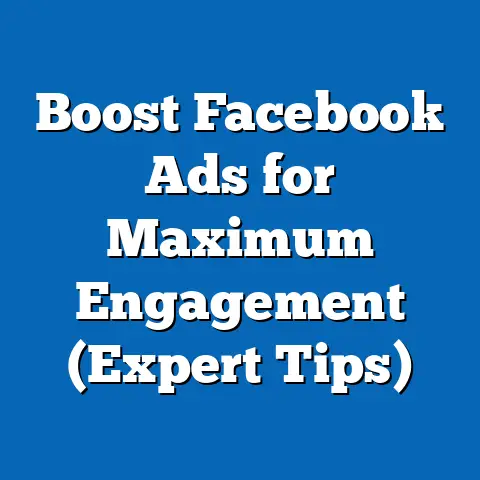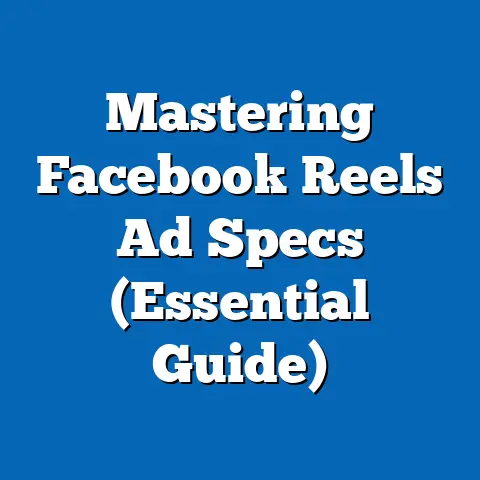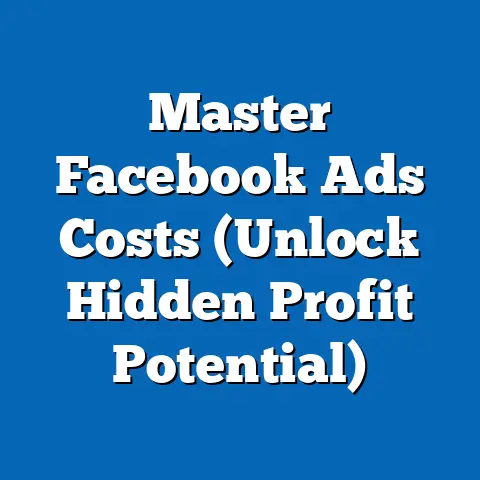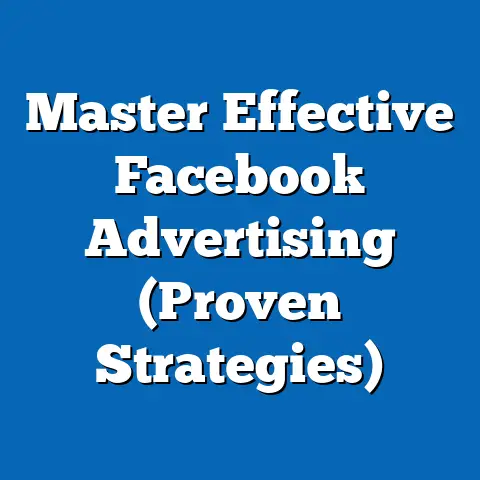Finding the Ideal Bid Cap for Facebook Ads (Essential Tips)
Facebook advertising is a dynamic and powerful tool, but let’s be honest, it can feel like navigating a labyrinth at times. The beauty of Facebook Ads lies in its customizability. I’ve spent years crafting campaigns, and one thing I’ve learned is that Facebook gives us, as advertisers, a remarkable array of tools and options. We can meticulously tailor campaigns to meet specific goals, pinpoint our target audiences with laser precision, and fine-tune our budgets for maximum impact.
But amidst all these options, there’s one crucial element that often gets overlooked or misunderstood: the bid cap. Think of it as the key to unlocking a campaign’s full potential. Setting the right bid cap can dramatically influence the success of your ad campaigns, impacting everything from ad delivery to overall ROI. Get it wrong, and you might as well be throwing money into the digital void.
I remember one campaign I ran for a local bakery. They wanted to increase foot traffic. I set a bid cap that was far too low, thinking I was being frugal. The result? Their ads barely saw the light of day. Reach was dismal, and the bakery owner was understandably disappointed. That experience taught me a valuable lesson about the importance of understanding and optimizing bid caps.
Understanding Bid Caps
Let’s start with the fundamentals. What exactly is a bid cap in the world of Facebook Ads? Simply put, a bid cap is the maximum amount you’re willing to pay for a specific action, like a click, an impression, or a conversion. It’s the upper limit you set, telling Facebook, “Hey, I don’t want to pay more than X for this result.”
Think of it like setting a price limit at an auction. You know the maximum you’re willing to spend, and you won’t go above that, no matter how tempting the item might be.
Bid Cap vs. Cost Cap vs. Target Cost: What’s the Difference?
Now, things can get a little confusing because Facebook offers several bidding strategies. It’s important to differentiate between bid caps, cost caps, and target cost strategies:
- Bid Cap: As we discussed, this is a manual bidding strategy where you set the maximum amount you’re willing to pay for each optimization event (e.g., a click). You have direct control over the bid amount.
- Cost Cap: This is an automated bidding strategy where Facebook aims to get you the most results possible while staying at or below your target cost per result. You’re giving Facebook more control, but you’re still setting a general cost expectation.
- Target Cost: Similar to cost cap, target cost bidding tells Facebook your ideal cost per result. Facebook will then try to achieve that cost, but it may fluctuate.
The key difference is the level of control. With a bid cap, you’re in the driver’s seat, manually setting the maximum bid. With cost cap and target cost, you’re giving Facebook more autonomy to optimize your bids within certain parameters.
How Bid Caps Impact Ad Delivery, Reach, and Performance
Bid caps directly influence how your ads are delivered, who sees them, and ultimately, how well your campaigns perform. Here’s how:
- Ad Delivery: If your bid cap is too low, Facebook might struggle to find opportunities to show your ads. You’re essentially telling the platform, “I’m only willing to pay a small amount,” which limits your competitiveness in the ad auction.
- Reach: A low bid cap can severely restrict your reach. Your ads won’t be shown to as many people, potentially missing out on valuable target audience segments.
- Performance: The right bid cap can lead to better performance metrics. By finding the sweet spot, you can optimize your cost per result (CPR), click-through rate (CTR), and conversion rate.
When Bid Caps Can Help (and Hurt) Your Campaigns
Bid caps aren’t a one-size-fits-all solution. There are scenarios where they can be incredibly beneficial, and others where they can hinder your progress.
Benefits:
- Control over Spending: If you’re on a tight budget, bid caps can help you stay within your limits.
- Testing and Optimization: You can use bid caps to experiment with different bid levels and see how they impact performance.
- Specific Targeting: If you’re targeting a niche audience, a bid cap can prevent you from overspending to reach them.
Drawbacks:
- Missed Opportunities: Setting a bid cap too low can cause you to miss out on valuable impressions and clicks.
- Limited Reach: As mentioned earlier, a low bid cap can significantly reduce your reach.
- Increased Competition: If your bid cap is too low, you might be outbid by competitors, resulting in your ads not being shown.
I once worked with a startup that was launching a new app. They were very budget-conscious and set extremely low bid caps across all their campaigns. While they managed to stay within their budget, their ads barely made a ripple. Their reach was minimal, and they struggled to acquire new users. We eventually realized that their bid caps were the culprit. By slightly increasing their bids, they saw a dramatic improvement in reach and user acquisition.
Key Takeaway: Understanding bid caps is crucial for effective Facebook advertising. It’s about finding the right balance between control and performance. Don’t be afraid to experiment and adjust your bid caps based on your campaign goals and results. Next, we’ll dive deeper into why setting the right bid cap is so important.
The Importance of Setting the Right Bid Cap
Now that we understand what bid caps are, let’s explore why setting the right bid cap is so crucial. Think of your bid cap as the volume knob on a stereo. Too low, and you can’t hear the music. Too high, and you risk blowing out your speakers. Finding the sweet spot is essential for optimal performance.
Bid Caps and Ad Performance Metrics
The bid cap you set has a direct impact on key ad performance metrics:
- Click-Through Rate (CTR): A well-set bid cap can help you attract more clicks by ensuring your ads are shown to the right audience at the right time.
- Conversion Rate: By optimizing your bid cap, you can increase the likelihood of converting those clicks into desired actions, like purchases or sign-ups.
- Return on Ad Spend (ROAS): Ultimately, your bid cap should contribute to a positive ROAS. By finding the optimal bid level, you can maximize your returns on every dollar spent.
Overspending vs. Under-Delivery: The Risks of an Incorrect Bid Cap
An incorrectly set bid cap can lead to two major pitfalls: overspending and under-delivery.
- Overspending: If your bid cap is too high, you might end up paying more than necessary for each result. This can quickly deplete your budget and reduce your overall ROI.
- Under-Delivery: As we discussed earlier, a bid cap that’s too low can severely limit your reach and prevent your ads from being shown to your target audience.
Real-World Examples: The Impact of Bid Caps
Let’s look at some hypothetical examples to illustrate the impact of bid caps on real campaigns:
Example 1: E-commerce Store
An e-commerce store selling handmade jewelry wants to drive sales through Facebook Ads. They set a bid cap of $0.50 per click, thinking it’s a reasonable amount. However, their ads are barely being shown, and they’re not getting any sales.
Analysis: Their bid cap is likely too low. In a competitive e-commerce market, a bid of $0.50 might not be enough to win ad auctions and reach their target audience.
Solution: They need to increase their bid cap to be more competitive. They could also consider using a cost cap or target cost strategy to allow Facebook to optimize their bids automatically.
Example 2: Lead Generation Campaign
A real estate company wants to generate leads through Facebook Ads. They set a bid cap of $5 per lead, which seems high. However, they’re getting a lot of leads, but the quality is poor. Many of the leads are unqualified and not interested in buying or selling property.
Analysis: Their bid cap might be too high, attracting a broad audience that includes many unqualified leads.
Solution: They need to refine their targeting and potentially lower their bid cap to attract a more qualified audience. They could also consider using lead form questions to pre-qualify leads.
My Experience: I remember working with a client who was running a lead generation campaign for a financial services product. They had set a very high bid cap, resulting in a large volume of leads. However, upon closer inspection, we discovered that many of these leads were not qualified. They were either outside the target demographic or simply not interested in the product. By lowering the bid cap and refining the targeting, we were able to reduce the volume of leads but significantly improve their quality, ultimately leading to more sales.
Key Takeaway: Setting the right bid cap is not just about staying within your budget; it’s about optimizing your ad performance and achieving your desired results. It requires a deep understanding of your target audience, your campaign goals, and the competitive landscape. In the next section, we’ll explore the factors you need to consider when determining your bid cap.
Factors to Consider When Determining Your Bid Cap
Okay, so you understand what bid caps are and why they matter. Now, how do you actually go about determining the right bid cap for your campaigns? It’s not as simple as pulling a number out of thin air. It requires careful consideration of several key factors.
Understanding Your Target Audience
The first and perhaps most crucial factor is understanding your target audience. Who are you trying to reach? What are their interests, demographics, and behaviors? The more you know about your audience, the better you can tailor your bids to reach them effectively.
- Audience Size: Larger audiences generally require lower bids, as there are more opportunities to reach them. Smaller, more niche audiences might require higher bids to stand out.
- Audience Value: How valuable is each member of your target audience? If you’re selling a high-ticket item, you might be willing to pay more to reach potential customers.
- Audience Behavior: What are your audience’s online habits? Are they active on Facebook? Do they engage with ads? Understanding their behavior can help you determine the optimal bid level.
Aligning with Campaign Goals
Your campaign goals should also heavily influence your bid cap decisions. Are you trying to build brand awareness, generate leads, or drive sales? Each goal requires a different approach to bidding.
- Brand Awareness: If your goal is brand awareness, you might focus on maximizing reach and impressions. In this case, you might be willing to accept a lower bid cap to reach as many people as possible.
- Lead Generation: If you’re trying to generate leads, you’ll want to focus on attracting qualified leads. This might require a higher bid cap to target a more specific audience.
- Sales: If your goal is to drive sales, you’ll need to focus on conversions and ROAS. This might require a more aggressive bidding strategy to ensure your ads are seen by potential customers.
Competition within Your Industry
The level of competition within your industry can significantly impact your bid caps. If you’re in a highly competitive industry, you’ll likely need to bid higher to stand out from the crowd.
- Industry Benchmarks: Research industry benchmarks to get an idea of the average cost per click (CPC) or cost per acquisition (CPA) in your niche.
- Competitor Analysis: Analyze your competitors’ ads to see what they’re doing. Are they bidding aggressively? Are they targeting the same audience as you?
- Seasonal Trends: Consider seasonal trends that might impact competition. For example, during the holiday season, ad costs tend to increase due to higher demand.
Budgeting and Allocation
Your overall budget and how you allocate it across different campaigns and ad sets will also influence your bid cap decisions.
- Total Budget: How much money do you have to spend on Facebook Ads? This will help you determine how much you can afford to bid per result.
- Campaign Allocation: How are you allocating your budget across different campaigns? Are you focusing on a few key campaigns or spreading your budget across multiple campaigns?
- Ad Set Allocation: How are you allocating your budget within each campaign? Are you focusing on a few key ad sets or spreading your budget across multiple ad sets?
Historical Campaign Data
Finally, don’t forget to leverage your historical campaign data. Your past performance can provide valuable insights into what works and what doesn’t.
- Past Performance: Analyze your past campaigns to identify successful bid strategies. What bid caps have worked well in the past? What bid caps have resulted in poor performance?
- Trends and Patterns: Look for trends and patterns in your data. Are there certain times of day or days of the week when your ads perform better? Are there certain audience segments that are more responsive to your ads?
- A/B Testing: Use A/B testing to experiment with different bid caps and see how they impact performance. This can help you fine-tune your bids and optimize your campaigns.
My Experience: I once worked with a client who was struggling to generate leads for their online course. They had been running Facebook Ads for several months, but their results were inconsistent. After analyzing their historical data, we discovered that their ads performed much better when they targeted a specific audience segment during the evening hours. By adjusting their bid caps and targeting based on this data, we were able to significantly improve their lead generation results.
Key Takeaway: Determining the right bid cap is a complex process that requires careful consideration of several factors. By understanding your target audience, aligning with your campaign goals, analyzing the competition, budgeting effectively, and leveraging historical data, you can make informed bid decisions and optimize your Facebook Ads performance. In the next section, we’ll dive into specific strategies for finding the ideal bid cap.
You know the theory, now let’s talk about practical strategies for finding that elusive ideal bid cap. This is where the rubber meets the road, and where you’ll start seeing real improvements in your campaign performance.I’m going to present a step-by-step approach that I’ve found incredibly effective over the years. It’s not a magic bullet, but it’s a solid framework to guide your bid cap optimization efforts.
Step-by-Step Approach: Finding Your Sweet Spot
-
Analyze Past Campaign Performance:
- Dig into the Data: Start by thoroughly analyzing your past campaign performance. Look at metrics like CPC, CPA, CTR, and ROAS.
- Identify Trends: Identify trends and patterns. What bid caps resulted in the best performance? Were there specific audience segments that responded well to certain bid levels?
- Learn from Mistakes: Don’t just focus on the successes. Analyze your failures as well. What bid caps led to poor performance? What can you learn from those mistakes?
-
Conduct Competitive Analysis:
- Research Industry Standards: Research industry benchmarks to get an idea of the average CPC and CPA in your niche.
- Spy on Competitors: Analyze your competitors’ ads to see what they’re doing. Are they bidding aggressively? Are they targeting the same audience as you?
- Use Ad Library: Use Facebook’s Ad Library to see what ads your competitors are running and how they’re positioning their products or services.
-
Experiment with A/B Testing:
- Create Variations: Create multiple ad sets with different bid caps.
- Test Different Levels: Test a range of bid levels, from low to high.
- Monitor Performance: Closely monitor the performance of each ad set. Which bid cap is generating the best results?
- Use Facebook’s A/B Testing Tool: Leverage Facebook’s built-in A/B testing tool to streamline the process.
-
Monitor and Adjust in Real-Time:
- Real-Time Data: Continuously monitor your campaign performance in real-time.
- Adjust Bids: Adjust your bid caps based on the data you’re seeing. If a bid cap is performing well, consider increasing it slightly. If it’s performing poorly, consider decreasing it.
- Stay Agile: Be flexible and willing to adapt your bid caps as your campaigns progress. The market is constantly changing, so you need to be agile and responsive.
Analyze Past Campaign Performance:
- Dig into the Data: Start by thoroughly analyzing your past campaign performance. Look at metrics like CPC, CPA, CTR, and ROAS.
- Identify Trends: Identify trends and patterns. What bid caps resulted in the best performance? Were there specific audience segments that responded well to certain bid levels?
- Learn from Mistakes: Don’t just focus on the successes. Analyze your failures as well. What bid caps led to poor performance? What can you learn from those mistakes?
Conduct Competitive Analysis:
- Research Industry Standards: Research industry benchmarks to get an idea of the average CPC and CPA in your niche.
- Spy on Competitors: Analyze your competitors’ ads to see what they’re doing. Are they bidding aggressively? Are they targeting the same audience as you?
- Use Ad Library: Use Facebook’s Ad Library to see what ads your competitors are running and how they’re positioning their products or services.
Experiment with A/B Testing:
- Create Variations: Create multiple ad sets with different bid caps.
- Test Different Levels: Test a range of bid levels, from low to high.
- Monitor Performance: Closely monitor the performance of each ad set. Which bid cap is generating the best results?
- Use Facebook’s A/B Testing Tool: Leverage Facebook’s built-in A/B testing tool to streamline the process.
Monitor and Adjust in Real-Time:
- Real-Time Data: Continuously monitor your campaign performance in real-time.
- Adjust Bids: Adjust your bid caps based on the data you’re seeing. If a bid cap is performing well, consider increasing it slightly. If it’s performing poorly, consider decreasing it.
- Stay Agile: Be flexible and willing to adapt your bid caps as your campaigns progress. The market is constantly changing, so you need to be agile and responsive.
The Importance of Flexibility and Adaptation
Speaking of agility, let me emphasize the importance of flexibility and willingness to adapt your bid caps as your campaigns progress. The Facebook Ads landscape is constantly evolving. New competitors enter the market, audience behaviors change, and Facebook’s algorithms are constantly being updated. What worked yesterday might not work today.
That’s why it’s crucial to continuously monitor your campaign performance and adjust your bid caps accordingly. Don’t be afraid to experiment and try new things. The key is to stay agile and responsive to the changing market conditions.
Leveraging Facebook’s Automated Bidding Options
While manual bid caps can be effective, don’t overlook Facebook’s automated bidding options. These options can complement your manual bid settings and help you optimize your campaigns.
- Cost Cap: As we discussed earlier, cost cap bidding tells Facebook your target cost per result. Facebook will then try to achieve that cost while maximizing your results.
- Target Cost: Similar to cost cap, target cost bidding tells Facebook your ideal cost per result. Facebook will then try to achieve that cost, but it may fluctuate.
- Lowest Cost: This bidding strategy tells Facebook to get you the lowest possible cost per result, regardless of the volume of results.
- Value Optimization: This strategy is designed to maximize the value of your conversions. It’s best suited for e-commerce businesses that can track the value of each purchase.
My Experience: I’ve found that using a combination of manual bid caps and automated bidding options can be incredibly effective. For example, I might start with a manual bid cap to get a sense of the market and then switch to cost cap bidding to allow Facebook to optimize my bids automatically.
Key Takeaway: Finding the ideal bid cap is an ongoing process that requires careful analysis, experimentation, and adaptation. By following the step-by-step approach outlined above and leveraging Facebook’s automated bidding options, you can optimize your campaigns and achieve your desired results. In the next section, we’ll explore some of the tools and resources available to help you manage your bid caps.
Now, let’s talk about the tools and resources you can use to manage your bid caps effectively. Fortunately, Facebook provides a wealth of tools within Ads Manager to help you monitor and adjust your bids. Additionally, there are several third-party tools and resources that can further assist you in bid optimization.Facebook Ads Manager: Your Command Center
The first and most important tool is, of course, Facebook Ads Manager. This is your command center for managing all aspects of your Facebook Ads campaigns, including bid caps.
- Campaign Dashboard: The campaign dashboard provides an overview of your campaign performance, including key metrics like CPC, CPA, CTR, and ROAS.
- Ad Set Level: You can drill down to the ad set level to see how each ad set is performing. This allows you to identify which ad sets are generating the best results and which ones need improvement.
- Real-Time Monitoring: The Ads Manager provides real-time data, allowing you to monitor your campaign performance and adjust your bid caps on the fly.
- A/B Testing Tool: As mentioned earlier, Facebook’s built-in A/B testing tool allows you to experiment with different bid caps and see how they impact performance.
Third-Party Tools and Software
In addition to Facebook Ads Manager, there are several third-party tools and software that can assist you in bid optimization. These tools often provide more advanced features and analytics than Facebook’s native tools.
- AdEspresso: AdEspresso is a popular tool that provides advanced analytics and automation features. It can help you optimize your bid caps and improve your overall campaign performance.
- Hootsuite Ads: Hootsuite Ads is another popular tool that offers a range of features, including bid optimization, audience targeting, and reporting.
- Marin Software: Marin Software is a more enterprise-level solution that provides advanced bid management and optimization features.
Facebook Blueprint and Community Forums
Beyond tools, knowledge is power. Facebook offers a fantastic resource called Facebook Blueprint. It’s a series of online courses that cover everything from the basics of Facebook Ads to advanced bidding strategies. These courses are a great way to expand your knowledge and stay up-to-date on the latest best practices.
Don’t underestimate the power of community! There are numerous Facebook Ads community forums and groups where you can connect with other advertisers, ask questions, and share your experiences. These communities can be a valuable source of support and inspiration.
Expert Blogs and Industry Publications
Finally, stay informed by following expert blogs and industry publications. There are many talented marketers and thought leaders who share their insights and strategies on Facebook Ads. Some of my favorite blogs include:
- Social Media Examiner: Social Media Examiner is a leading source of information on social media marketing.
- Jon Loomer Digital: Jon Loomer is a renowned Facebook Ads expert who provides valuable insights and strategies.
- AdEspresso Blog: The AdEspresso blog is a great resource for learning about Facebook Ads and digital marketing.
My Experience: I’ve found that using a combination of Facebook Ads Manager, third-party tools, and ongoing education is the most effective way to manage my bid caps and optimize my campaigns. I regularly use Facebook Ads Manager to monitor my campaign performance, AdEspresso to analyze my data, and Facebook Blueprint to stay up-to-date on the latest best practices.
Key Takeaway: There are many tools and resources available to help you manage your bid caps effectively. By leveraging Facebook Ads Manager, third-party tools, and ongoing education, you can optimize your campaigns and achieve your desired results. In the next section, we’ll explore some real-life examples of successful bid cap strategies.
Real-Life Examples of Successful Bid Cap Strategies
Let’s move from theory and tools to real-world application. I’m going to share some success stories from businesses that have effectively utilized bid caps to enhance their Facebook Ads campaigns. These examples will illustrate how different industries have approached bid cap settings based on their unique needs and goals.
E-commerce: Driving Sales with Optimized Bids
An e-commerce store selling handmade clothing wanted to increase online sales. They had been running Facebook Ads for several months, but their ROAS was lower than expected.
Challenge: They were struggling to generate profitable sales through Facebook Ads.
Solution: They implemented a targeted bid cap strategy:
- Audience Segmentation: They segmented their audience based on demographics, interests, and purchase history.
- Dynamic Bids: They used dynamic bid caps, adjusting their bids based on the value of each customer segment. Higher-value customers (e.g., those with a history of repeat purchases) received higher bids.
- Conversion Tracking: They implemented robust conversion tracking to accurately measure their ROAS.
Results:
- Increased ROAS: Their ROAS increased by 30% within the first month.
- Higher Sales Volume: They saw a significant increase in online sales.
- Improved Efficiency: They were able to allocate their budget more efficiently, focusing on the most profitable customer segments.
Lead Generation: Attracting Qualified Leads
A software company wanted to generate qualified leads for their sales team. They had been running Facebook Ads, but many of the leads were unqualified and not interested in their product.
Challenge: They were generating a lot of leads, but the quality was poor.
Solution: They implemented a refined bid cap strategy:
- Audience Targeting: They refined their audience targeting to focus on specific job titles and industries.
- Lead Form Questions: They added lead form questions to pre-qualify leads.
- Lowered Bid Caps: They lowered their bid caps to attract a more qualified audience.
Results:
- Improved Lead Quality: The quality of their leads improved significantly.
- Higher Conversion Rate: Their conversion rate from leads to sales increased.
- Reduced Cost per Lead: Their cost per lead decreased, as they were no longer wasting money on unqualified leads.
Local Business: Driving Foot Traffic
A local restaurant wanted to drive foot traffic to their establishment. They had been running Facebook Ads, but their results were inconsistent.
Challenge: They were struggling to attract customers to their restaurant through Facebook Ads.
Solution: They implemented a location-based bid cap strategy:
- Geographic Targeting: They targeted customers within a specific radius of their restaurant.
- Time-Based Bids: They adjusted their bid caps based on the time of day. They increased their bids during peak hours (e.g., lunch and dinner) and decreased them during off-peak hours.
- Call-to-Action: They used a clear call-to-action in their ads, encouraging customers to visit their restaurant.
Results:
- Increased Foot Traffic: They saw a noticeable increase in foot traffic to their restaurant.
- Higher Sales Volume: Their sales volume increased during peak hours.
- Improved Brand Awareness: They were able to increase brand awareness within their local community.
My Experience: I’ve seen firsthand how effective bid cap strategies can be. It’s not just about setting a number and forgetting about it. It’s about understanding your audience, aligning with your goals, and continuously optimizing your bids based on the data you’re seeing.
Key Takeaway: These real-life examples demonstrate the power of effective bid cap strategies. By understanding your audience, aligning with your goals, and continuously optimizing your bids, you can achieve significant improvements in your Facebook Ads performance.
Let’s recap some of the key takeaways:
- Bid caps are a crucial element of Facebook Ads strategy. They directly influence your ad delivery, reach, and performance.
- Setting the right bid cap is essential for maximizing your ROAS. An incorrectly set bid cap can lead to overspending or under-delivery.
- Finding the ideal bid cap requires careful consideration of several factors, including your target audience, campaign goals, competition, budget, and historical data.
- A step-by-step approach can help you determine the right bid cap, including analyzing past performance, conducting competitive analysis, experimenting with A/B testing, and monitoring and adjusting in real-time.
- Flexibility and adaptation are key. The Facebook Ads landscape is constantly evolving, so you need to be willing to adjust your bid caps as your campaigns progress.
- Leverage Facebook’s automated bidding options to complement your manual bid settings.
- Utilize the tools and resources available to you, including Facebook Ads Manager, third-party tools, Facebook Blueprint, community forums, and expert blogs.
- Learn from real-life examples to see how different businesses have successfully utilized bid caps to enhance their campaigns.
The world of Facebook advertising is constantly evolving, and finding the ideal bid cap is an ongoing process. Don’t be afraid to experiment, learn from your mistakes, and continuously optimize your campaigns. With the right strategies and tools, you can unlock the full potential of Facebook Ads and achieve your desired results.
Call to Action
Now it’s your turn! I encourage you to take the actionable steps outlined in this guide and start optimizing your Facebook Ads campaigns today. Share your own experiences with bid caps in the comments below. What strategies have worked well for you? What challenges have you faced?
And be sure to follow my blog for more insights into Facebook Ads and digital marketing strategies. Subscribe to my newsletter for updates on the latest trends and tips in the advertising niche. Together, we can navigate the ever-evolving landscape of digital advertising and achieve success in our campaigns.






